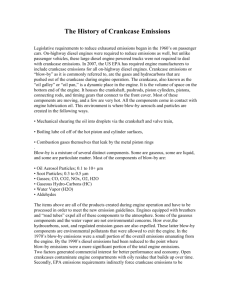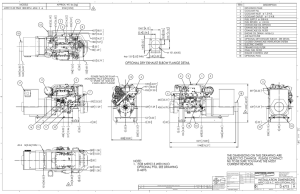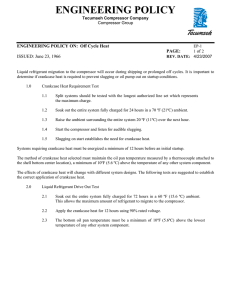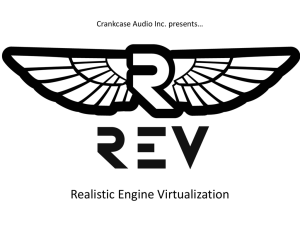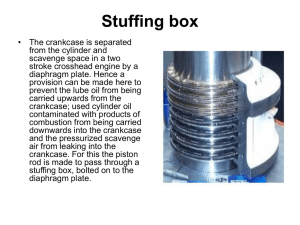Retrofit Crankcase Ventilation for Diesel Engines
advertisement
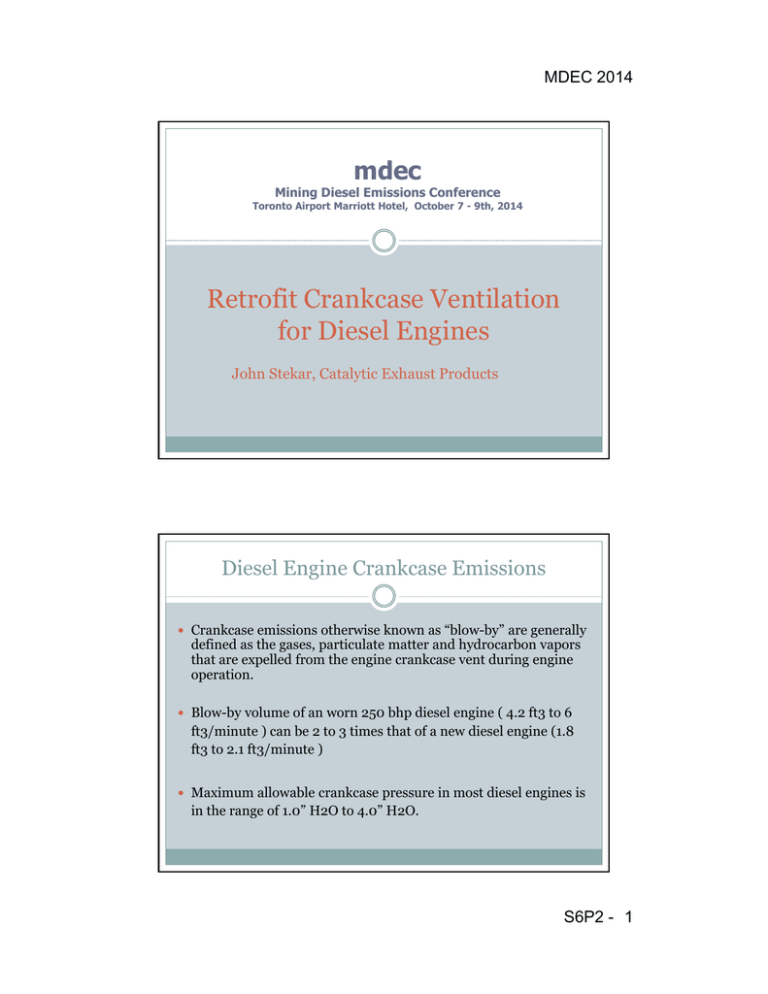
MDEC 2014 mdec Mining Diesel Emissions Conference Toronto Airport Marriott Hotel, October 7 - 9th, 2014 Retrofit Crankcase Ventilation for Diesel Engines John Stekar, Catalytic Exhaust Products Diesel Engine Crankcase Emissions y Crankcase emissions otherwise known as “blow-by” are generally defined as the gases, particulate matter and hydrocarbon vapors that are expelled from the engine crankcase vent during engine operation. y Blow-by volume of an worn 250 bhp diesel engine ( 4.2 ft3 to 6 ft3/minute ) can be 2 to 3 times that of a new diesel engine (1.8 ft3 to 2.1 ft3/minute ) y Maximum allowable crankcase pressure in most diesel engines is in the range of 1.0” H2O to 4.0” H2O. S6P2 - 1 MDEC 2014 Diesel Engine Crankcase Emissions yContaminated crankcase emissions can be a very serious problem for diesel engines. Oil mist, particulate matter and water escaping past the piston rings and piston ring gaps due to high pressures in the crankcase, can travel throughout the engine, causing many different problems. Diesel Engine Crankcase Emissions Composition y Blow-by is composed of : 1) Oil Aerosols 2) Particulate Matter ( 5% to 16% of total PM* ) - particle diameter range of 0.5 to 5.0 micrometers. 3) Carbon Monoxide ( 1.3% of total CO ) 4) Carbon Dioxide 5) Oxides of Nitrogen ( 0.1% of total NOx ) 6) Oxygen 7) Hydrocarbons ( 3.7% of total THC** ) 8) Water vapor * Hot start FTP HD transient test cycle of 2 Cummins and 2 DDC 350-400 hp diesel engines ** Diesel engines with worn piston rings can increase hydrocarbon emissions to 20% of total hydrocarbon emissions. S6P2 - 2 MDEC 2014 Diesel Engine Tailpipe PM versus Crankcase PM Emissions How Blow-by is created 1) 2) 3) Mechanical shear (camshaft, valve train, connecting rods, etc…) of crankcase oil into droplets Boiling of crankcase oil on hot engine piston, cylinder surfaces, turbocharger shaft, valve stems, etc… Leakage of compression and combustion gases past piston rings and through the piston ring gap S6P2 - 3 MDEC 2014 Off-road Crankcase Emissions Regulations y EPA Nonroad Compression-Ignition Engines – y Tier 2 and later model fuelled naturally aspirated engines shall not discharge crankcase emissions into the atmosphere unless these emissions are permanently routed into the exhaust. This prohibition does not apply to engines using turbochargers, pumps, blowers or superchargers. y Tier 2 exhaust emissions standards were implemented between 2001 and 2006. y Therefore retro-fit crankcase ventilation systems are best suited for Tier 0 / Tier 1 non-road diesel engines and turbocharged Tier 2 non-road diesel engines. On-road Crankcase Emissions Regulations y Control of engine crankcase emissions was mandated on on-road gasoline fueled automobiles in the 1960’s. y Control of crankcase emissions on on-highway naturally aspirated diesel engines was not mandated until 2004. In 2007 for turbocharged and supercharged on-road diesel engines the crankcase emissions must be added to the exhaust emissions during all testing. Deterioration of engine crankcase emissions must also be accounted for in exhaust deterioration factors. S6P2 - 4 MDEC 2014 Neshap Rice Emissions Regulations for Gensets y Current Neshap Rice regulations for existing non‐emergency CI engines larger than 300 HP require: Installation of a DOC to reduce engine exhaust emissions Initial performance test to demonstrate compliance with emission limit Use ultra low sulfur diesel fuel Submit required notifications Submit semiannual compliance reports (annual if engine operates less than 100 hours per calendar year) y Install a closed crankcase ventilation (CCV) or open crankcase ventilation (OCV) system y If larger than 500 HP: y y y y y o o o o o o subsequent performance testing every 8,760 hours of operation or 3 years, whichever comes first (every 5 years if engine operates less than 100 hours per calendar year) keep catalyst pressure drop within 2 inches of water from pressure drop measured during initial performance test; measure and record catalyst pressure drop monthly keep catalyst inlet temperature between 450‐1,350°F; continuously monitor and record catalyst inlet temperature Negative Effects of Diesel Engine Crankcase Emission Pollutants y Crankcase emissions can be a significant source of vehicle self-pollution, or the migration of a vehicle’s own emissions into the passenger compartment. y Oil mist blow by can clog engine and hydraulic cooling radiators and reduce cooling capacity. y Oil mist blow by can contaminate operating environments. y Lack of oil mist recovery can be responsible for 10% to 20% of total crankcase oil consumption in severe cases. S6P2 - 5 MDEC 2014 Retrofit Crankcase Ventilation Systems • Retrofit crankcase ventilation systems are designed to control the balance of air pressure between the engine crankcase and atmospheric pressure while controlling emissions and preventing contamination. • Retrofit crankcase ventilation systems provide 3 distinct functions: 1. Separate oil mist, particles, soot and liquid volatiles from the crankcase vent airflow 2. Return coalesced oil back to the engine crankcase 3. Regulate crankcase pressures within a range of -4.0” H2O to +4.0” H2O. Benefits of Retrofit Diesel Engine Crankcase Ventilation y Maintains reliability and reparability of engines. y Reduces engine oil consumption y Improves efficiency in comparison to diesel engines without crankcase ventilation y Reduces pollution and waste from crankcase emissions y Reduces smoke, odors, and other particulate matter in the surrounding environment S6P2 - 6 MDEC 2014 Diesel Engine Retrofit Crankcase Ventilation PM Reduction In Combination With DOC / DPF Crankcase Vent System = reduces PM by 5% to 16% Diesel Oxidation Catalyst (DOC) = reduces PM by 27% Crankcase Vent + DOC = reduces PM by 34% Diesel Particulate Filter (DPF) = reduces PM by 82% Crankcase Vent + DPF = reduces PM by 96% EPA Approved Manufacturers y On the EPA verified technologies list, the following manufacturers are have approved DOC used in conjunction with a CCV or OCV : y 1) Clean Diesel Technologies Inc. y 2) Cummins Emissions Solutions y 3) Donaldson S6P2 - 7 MDEC 2014 Types of crankcase ventilation systems A) Unfiltered Crankcase - vented to atmosphere B) Open Crankcase Ventilation C) Closed Crankcase Ventilation - gases vented to atmosphere - gases vented to intake system - PM and oil mist separated - PM and oil mist separated - filtered oil returned to crankcase - filtered oil returned to crankcase Closed Crankcase Ventilation and Heavy Duty Diesel Engines y Closed crankcase ventilation (CCV) systems are typically about 90% effective in reducing PM and oil mist. y However the remaining 10% of particulate matter and oil mist that passes through the CCV system can coke, buildup and alter the engine turbocharger compressor surfaces thereby reducing operating efficiency. Oil deposits can lead to plugging of the intercooler thereby reducing heat transfer. y Therefore many 2007 and newer heavy duty diesel engines are equipped with open crankcase ventilation (OCV) systems. S6P2 - 8 MDEC 2014 Retrofit CCV / OCV Cost y Retrofit CCV and OCV crankcase vents have a unit cost of approximately $480.00/unit for a 390 HP diesel engine. y Retrofit CCV and OCV crankcase vent filter elements have a unit cost of approximately $40.00/unit for a 390 HP diesel engine. Typical crankcase vent filter element life is in the range of 500 to 750 hours for a diesel engine is good operating condition. Caterpillar unfiltered crankcase vent S6P2 - 9 MDEC 2014 Caterpillar unfiltered crankcase vent hose Caterpillar unfiltered crankcase vent S6P2 - 10 MDEC 2014 Perkins unfiltered crankcase vent New Holland unfiltered crankcase vent ? S6P2 - 11 MDEC 2014 Perkins Closed Crankcase Vent Perkins Closed Crankcase Vent S6P2 - 12 MDEC 2014 Closed Crankcase Vent – Deutz Diesel Closed Crankcase Vent Pipe – Deutz Diesel S6P2 - 13 MDEC 2014 Caterpillar 924H Open Crankcase Vent Caterpillar 924H Open Crankcase Vent Hose S6P2 - 14 MDEC 2014 Caterpillar 924H Special Thanks to the following Sources y DieselNet.com y Cummins Filtration y EPA.gov y Parker – Racor y Caterpillar y Detroit Diesel Corporation S6P2 - 15
